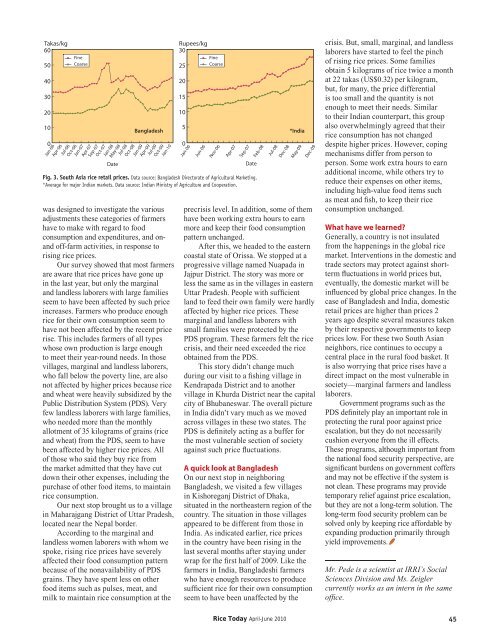A sunburned grain Stamps of approval Pockets of gold in ... - adron.sr
A sunburned grain Stamps of approval Pockets of gold in ... - adron.sr
A sunburned grain Stamps of approval Pockets of gold in ... - adron.sr
You also want an ePaper? Increase the reach of your titles
YUMPU automatically turns print PDFs into web optimized ePapers that Google loves.
Takas/kgRupees/kg60 30F<strong>in</strong>eF<strong>in</strong>e50Coarse25Coarse403020100Apr-06Jul-06Jan-06Oct-06Jan-07Apr-07Sep-07Oct-07Jan-08May-08Jul-08Oct-08DateBangladeshJan-09Apr-09Jul-09Oct-09was designed to <strong>in</strong>vestigate the variousadjustments these categories <strong>of</strong> farmershave to make with regard to foodconsumption and expenditures, and onand<strong>of</strong>f-farm activities, <strong>in</strong> response toris<strong>in</strong>g rice prices.Our survey showed that most farmersare aware that rice prices have gone up<strong>in</strong> the last year, but only the marg<strong>in</strong>aland landless laborers with large familiesseem to have been affected by such price<strong>in</strong>creases. Farmers who produce enoughrice for their own consumption seem tohave not been affected by the recent pricerise. This <strong>in</strong>cludes farmers <strong>of</strong> all typeswhose own production is large enoughto meet their year-round needs. In thosevillages, marg<strong>in</strong>al and landless laborers,who fall below the poverty l<strong>in</strong>e, are alsonot affected by higher prices because riceand wheat were heavily subsidized by thePublic Distribution System (PDS). Veryfew landless laborers with large families,who needed more than the monthlyallotment <strong>of</strong> 35 kilograms <strong>of</strong> <strong>gra<strong>in</strong></strong>s (riceand wheat) from the PDS, seem to havebeen affected by higher rice prices. All<strong>of</strong> those who said they buy rice fromthe market admitted that they have cutdown their other expenses, <strong>in</strong>clud<strong>in</strong>g thepurchase <strong>of</strong> other food items, to ma<strong>in</strong>ta<strong>in</strong>rice consumption.Our next stop brought us to a village<strong>in</strong> Maharajgang District <strong>of</strong> Uttar Pradesh,located near the Nepal border.Accord<strong>in</strong>g to the marg<strong>in</strong>al andlandless women laborers with whom wespoke, ris<strong>in</strong>g rice prices have severelyaffected their food consumption patternbecause <strong>of</strong> the nonavailability <strong>of</strong> PDS<strong>gra<strong>in</strong></strong>s. They have spent less on otherfood items such as pulses, meat, andmilk to ma<strong>in</strong>ta<strong>in</strong> rice consumption at the20151050Jan-06Jun-06Nov-06Apr-07Sep-07Feb-08Jul-08DateFig. 3. South Asia rice retail prices. Data source: Bangladesh Directorate <strong>of</strong> Agricultural Market<strong>in</strong>g.*Average for major Indian markets. Data source: Indian M<strong>in</strong>istry <strong>of</strong> Agriculture and Cooperation.Jan-10precrisis level. In addition, some <strong>of</strong> themhave been work<strong>in</strong>g extra hours to earnmore and keep their food consumptionpattern unchanged.After this, we headed to the easterncoastal state <strong>of</strong> Orissa. We stopped at aprogressive village named Nuapada <strong>in</strong>Jajpur District. The story was more orless the same as <strong>in</strong> the villages <strong>in</strong> easternUttar Pradesh. People with sufficientland to feed their own family were hardlyaffected by higher rice prices. Thesemarg<strong>in</strong>al and landless laborers withsmall families were protected by thePDS program. These farmers felt the ricecrisis, and their need exceeded the riceobta<strong>in</strong>ed from the PDS.This story didn’t change muchdur<strong>in</strong>g our visit to a fish<strong>in</strong>g village <strong>in</strong>Kendrapada District and to anothervillage <strong>in</strong> Khurda District near the capitalcity <strong>of</strong> Bhubaneswar. The overall picture<strong>in</strong> India didn’t vary much as we movedacross villages <strong>in</strong> these two states. ThePDS is def<strong>in</strong>itely act<strong>in</strong>g as a buffer forthe most vulnerable section <strong>of</strong> societyaga<strong>in</strong>st such price fluctuations.A quick look at BangladeshOn our next stop <strong>in</strong> neighbor<strong>in</strong>gBangladesh, we visited a few villages<strong>in</strong> Kishoreganj District <strong>of</strong> Dhaka,situated <strong>in</strong> the northeastern region <strong>of</strong> thecountry. The situation <strong>in</strong> those villagesappeared to be different from those <strong>in</strong>India. As <strong>in</strong>dicated earlier, rice prices<strong>in</strong> the country have been ris<strong>in</strong>g <strong>in</strong> thelast several months after stay<strong>in</strong>g underwrap for the first half <strong>of</strong> 2009. Like thefarmers <strong>in</strong> India, Bangladeshi farmerswho have enough resources to producesufficient rice for their own consumptionseem to have been unaffected by theRice Today April-June 2010*IndiaDec-08May-09Dec-09crisis. But, small, marg<strong>in</strong>al, and landlesslaborers have started to feel the p<strong>in</strong>ch<strong>of</strong> ris<strong>in</strong>g rice prices. Some familiesobta<strong>in</strong> 5 kilograms <strong>of</strong> rice twice a monthat 22 takas (US$0.32) per kilogram,but, for many, the price differentialis too small and the quantity is notenough to meet their needs. Similarto their Indian counterpart, this groupalso overwhelm<strong>in</strong>gly agreed that theirrice consumption has not changeddespite higher prices. However, cop<strong>in</strong>gmechanisms differ from person toperson. Some work extra hours to earnadditional <strong>in</strong>come, while others try toreduce their expenses on other items,<strong>in</strong>clud<strong>in</strong>g high-value food items suchas meat and fish, to keep their riceconsumption unchanged.What have we learned?Generally, a country is not <strong>in</strong>sulatedfrom the happen<strong>in</strong>gs <strong>in</strong> the global ricemarket. Interventions <strong>in</strong> the domestic andtrade sectors may protect aga<strong>in</strong>st shorttermfluctuations <strong>in</strong> world prices but,eventually, the domestic market will be<strong>in</strong>fluenced by global price changes. In thecase <strong>of</strong> Bangladesh and India, domesticretail prices are higher than prices 2years ago despite several measures takenby their respective governments to keepprices low. For these two South Asianneighbors, rice cont<strong>in</strong>ues to occupy acentral place <strong>in</strong> the rural food basket. Itis also worry<strong>in</strong>g that price rises have adirect impact on the most vulnerable <strong>in</strong>society—marg<strong>in</strong>al farmers and landlesslaborers.Government programs such as thePDS def<strong>in</strong>itely play an important role <strong>in</strong>protect<strong>in</strong>g the rural poor aga<strong>in</strong>st priceescalation, but they do not necessarilycushion everyone from the ill effects.These programs, although important fromthe national food security perspective, aresignificant burdens on government c<strong>of</strong>fersand may not be effective if the system isnot clean. These programs may providetemporary relief aga<strong>in</strong>st price escalation,but they are not a long-term solution. Thelong-term food security problem can besolved only by keep<strong>in</strong>g rice affordable byexpand<strong>in</strong>g production primarily throughyield improvements.Mr. Pede is a scientist at IRRI’s SocialSciences Division and Ms. Zeiglercurrently works as an <strong>in</strong>tern <strong>in</strong> the same<strong>of</strong>fi ce.45

















